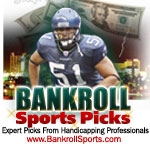Credit where Credit is Due
>> Monday
 First of all, despite our constant ragging on ESPN here at YCS, the folks at College Gameday put on a great show Saturday at the Bradley Center. I hope it came across half as crazy on TV as it was in person. Made me very proud to be a Marquette alum, and Digger and Bilas were cool in signing autographs and taking pictures with people afterwards.
First of all, despite our constant ragging on ESPN here at YCS, the folks at College Gameday put on a great show Saturday at the Bradley Center. I hope it came across half as crazy on TV as it was in person. Made me very proud to be a Marquette alum, and Digger and Bilas were cool in signing autographs and taking pictures with people afterwards.
Likewise, an interesting article in the Wall Street Journal of all places over the weekend on how professional and college sports teams are using crowd noise to increase their advantage. (It did also mention that that science only goes so far...ie: Cameron Indoor isn't a hard place to play because it's a famous gym. Cameron Indoor is a hard place to play because Duke plays there.)
Roar Wars: The New Science of Fan Power By RUSSELL ADAMS March 3, 2007
It's an article of faith among many fans that their cheers can help lift their teams to victory. Now, research suggests the effect is both real and potent -- and teams are taking new steps to harness fan power.
Oregon State University recently spent more than $500,000 to install football bleachers that make more noise when stomped on. The University of Maryland picked a relatively uncomfortable seating option for some sections of its Comcast Center to force fans onto their feet as often as possible.
The push for fan power is ratcheting up a cat-and-mouse game between teams looking for an edge and league officials charged with keeping things fair. A number of college-basketball conferences, including the ACC and the Big East, are cracking down on the practice of seating pep bands directly behind visitors' benches to make it harder for coaches to talk to their teams during timeouts.
Perhaps nothing is as contentious as relocating alumni to make way for raucous students. Ohio State says about 10% of the displaced regular-season ticket holders complained, and a few asked for refunds. "We didn't run anybody out of the building," says Bill Jones, the assistant athletic director for ticketing.
One of the power players in this business is Kansas City, Mo., architecture firm Ellerbe Becket and its longtime design director, James Poulson, who is emerging as a master of maximizing crowd noise. His firm recently completed construction of the University of Virginia's basketball arena and is working on one for Missouri State University.
Mr. Poulson made his name in the 1990s, overseeing construction of the Portland Trail Blazers' arena for owner and Microsoft co-founder Paul Allen. Mr. Allen, an avid fan of both music and sports, wanted the new venue to draw top bands for concerts but not if that meant using materials that would deaden crowd noise during basketball games. Ellerbe Becket came up with a novel although expensive solution: rotating ceiling panels with a soft, absorptive side for concerts and a hard side that reflects crowd noise back to the court during games.
Mr. Allen later hired Mr. Poulson to construct Qwest Field in Seattle. In addition to contracting engineers to make sure that the wind and rain would disproportionately hit the visitors' sideline, Mr. Poulson placed the cheapest endzone seats (where, he says, the "crazies" sit) atop steel risers that send thundering noise to the hard surfaces on the overhangs and roof, redirecting it back to the field. The Seahawks are among the NFL's leaders in false-start penalties called against visiting teams.
There's no debate that teams fare better at home. Sports statistician Jeff Sagarin says that if two teams of equal ability play, the home team would be expected to win 61% of the time in the NFL, just over 65% in the NBA and nearly 70% in college basketball. Teams play better at home for a variety of reasons beyond a cheering crowd, from their familiarity with the court or field to the toll that travel takes on visiting teams.
The article went on to cite studies where referees abroad on average handed out more penalties to visitors than to the home team, and cited other figures of which teams get the biggest boost when playing at home (skewed statistics since Duke is good both at home and on the road, and teams like North Dakota State lose almost everywhere they go, but play patsies at home. On the whole though, it was a pretty interesting read.






0 comments:
Post a Comment